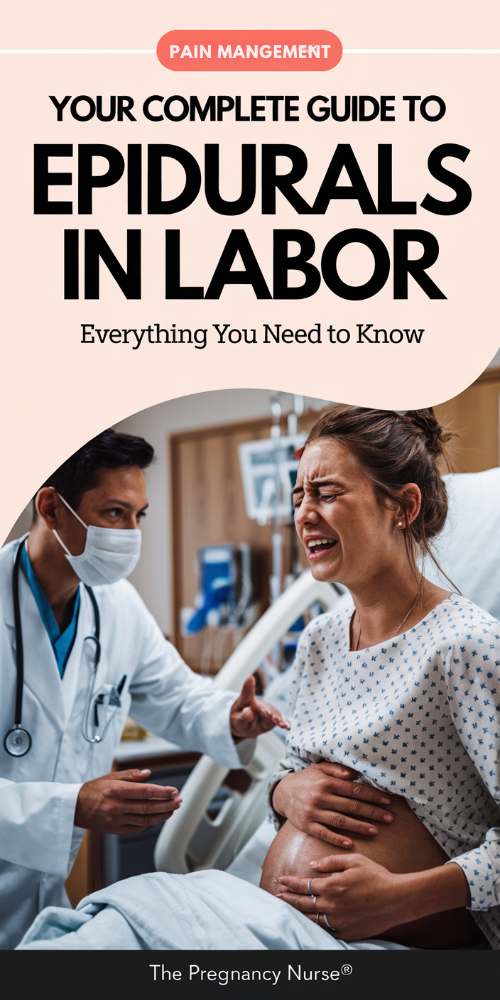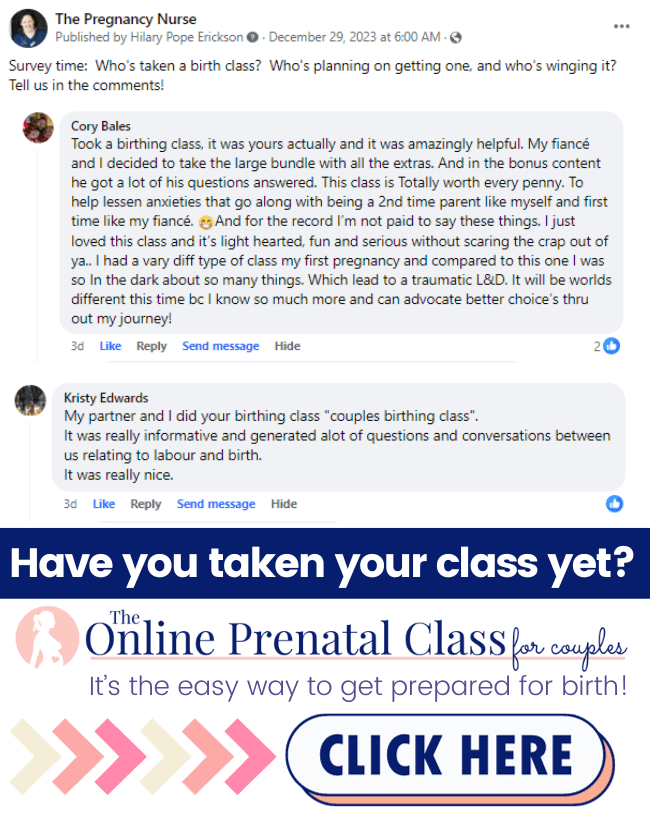👋 I’m so glad YOU are here. Are you looking to also get your partner prepared? This is for BOTH of you. Couples just love it and I know you want to both feel prepared!
You’re mulling over getting an epidural and you’d like more info? Well, I’m thrilled that you’re here. I’m excited to share some of the BEST tips on the internet about epidurals including some that no one talks about.

As a labor nurse for 20 years I definitely saw epidurals used right, and WRONG. I think some people think they just sleep til’ baby comes out, and while that is sometimes true there’s more to it than that. So, let’s get started on your complete guide to labor epidurals.
While we’re here, a reminder that while in the US the epidural is definitely the most popular form of pain management — but there are other options — happy to share those with you as well. This also talks about IV pain medicine and that is VERY much mis-understood so I’m here to clarify that too:
We’re gonna start at the very beginning. First off, a man and a woman love each other very much… Ok, maybe we’ll fast forward to when you’re actually in labor. 🙂
When can you get the epidural?

First off — to get an epidural you definitely have to actually be in labor (although, you can get an epidural prior to a version — but that’s a very different case). I will admit when I was a pregnant labor nurse, I was jealous of the epidurals. That sounded pretty darn nice. BUT you gotta be in labor to get one.
I really do recommend getting the epidural once you’re in pain, although some people do request the epidural before their induction starts. AND if they’re just going to break your water, a lot of people recommend getting the epidural before they break your water.
Frankly, I am still a fan of you having some pain (and promoting movement) until you feel like you’re ready for it — vs just getting the epidural in advance of the pain.
But, How Many CM Do You Need to Be to Get An Epidural? — is a question a lot of people ask. I will say that when I started in L&D it was very normal for providers to say that patients couldn’t get the epidural until 4 cm or something along those lines, but that isn’t really the case anymore.
Studies have shown that the epidural is best given when the patient wants it. If you’re really wanting to pick the best time for you, I’d recommend this post: The Best Time to Get an Epidural During Labor
While we’re here, talking about your hospital stay — have you thought about packing your bag? Grab my packing list right here:
Is it ever “too late” to get the epidural?

In a word, yes. But it’s complicated. I go into more in this post
What you really need to know is that on your first baby there is a very wide span of when you can get an epidural. Mostly because you likely have 1-2 hours of pushing ahead of you, and that is still a safe time to get an epidural.
However, on your second baby those last few centimeters can go much quicker and pushing time is very reduced. Often we say that about 7-8 centimeters is when you really need to decide on a 2+ baby.
Note: That would be a 2+ VAGINAL delivery — if you are having a VBAC with no prior vaginal deliveries it would be the same as first delivery.
Really quick — have you started your birth class? If not, there’s still time — I recommend this one!
How Is the Epidural Put In?
Ok, so I bet a LOT of you wonder how the epidural is put in. Totally normal. I actually go through the whole process with a doll, using common (less scary) household supplies to show you how in here:
But, I bet one of the questions most of you wonder is — How Bad Does the Epidural Hurt? << that post has tons of info, but most people think it’s actually less painful than the IV stick.
Pro Tip: You WILL need an IV to get an epidural (although it can be run as a saline lock until you request an epidural as long as you’re low-risk).
You may also wonder — who Administers an Epidural? Most often it’s an anesthesiologist, but it may be a CRNA (sort of like a nurse practitioner for anesthesiology). It’s important to know that it is NOT your OB — that isn’t their specialty, so it is given by another provider.
And, as a ANOTHER pro tip — you’re welcome to ask to speak with the anesthesiologist well before you want the epidural if you have questions to ask them. Many of them love to come in and have a conversation about risks and benefits with you before the pains get too much — so that’s something to consider as well.
There are a couple of types of epidurals — Epidural vs Spinal: Which is best for you? The reality is that it’s best to get whatever kind the provider giving you the epidural is good at. I just think it’s good info to have.
Now, if you’re really worried about the needle or the pain of the epidural I have a good podcast episode for you:
Tailoring Your Epidural to YOU

This is a real pro tip that not a lot of people talk about. You may have heard of the walking epidural…
but I gotta say that while MOST hospitals don’t provide a “walking epidural” there is actually a lot that we can learn from walking epidurals.
Mostly that the epidural can be tailored to what you need.
Most often the anesthesiologist will just ask us to set the epidural pump to a “rate” and then they leave (that rate being the same for everyone). However, if you’re feeling too numb or you’re feeling TOO MUCH you can ask just to change that rate. I like to think of that as a “starting” rate — and then we can adjust as needed (especially after you get a nap in for some energy).
The good news is that pump can go up and it can go down. Depending on your hospital you may need to speak with the anesthesiologist to change the rate — but that’s your right.
The real sweet spot of an epidural is when you’re still able to move, but only feeling about 20% of the pain. And you can really tailor that epidural to YOU!
If you, right now — are thinking, huh — I never knew that? I’m right there with you. I either had epidurals that left me in a lot of pain, or so numb I had no idea I even had legs — I couldn’t move them at ALL.
But, pro tips like tailoring your epidural to YOU are what can truly make your labor extra good. I learned so much in here — I think you will too! Tons more pro tips like this one in there!

Does Labor Still Hurt with an Epidural?

The thing is, as you tailor an epidural to what you need — there is likely going to be some pain.
And honestly, they really want you to be able to feel SOMETHING. That allows you to be able to move some in bed, and also get some feedback that baby is moving down the birth canal and when it’s time to push.
I do have a whole article on this:
However, labor has several stages, so it’s good to know what to expect as you advance through them (especially right at delivery) — I think you’ll find these articles helpful.
That being said, I always sort of wondered — What Does Having an Epidural Feel Like? << that post has tons of info, but it is very similar to how your leg feels when it’s fallen “asleep” — you just don’t get that pins and needles feeling as it “wakes” back up — it just stays asleep. Sort of numb.
It think it’s important to remember that the epidural isn’t designed to completely take the pain away. Because, this is the case — it’s important to remember that breathing is an important tool to have, to learn to relax even when it’s hurting. This is true both before the epidural and afterwards (and frankly, as you raise that sweet babe).
I think any good birth class should include breathing. This one has a whole natural pain management bonus video to help you learn both breathing and some other awesome techniques to help. I recommend everyone watch it — planning on an epidural or not.
That being said — I often see a LOT of gas-lighting from anesthesia that it’s “just pressure” that people are feeling — not pain. This is them, not really wanting to do their job….
What to do if your epidural doesn’t work?

If you’re feeling more pain then you’d prefer I’d 100% ask to see them (you may have to be insistant). I have a whole post on what to do if this is the case:
Ok, let’s get into the nitty gritty of the epidural:
How long will the epidural last?

A LOT of people wonder if they get the epidural too early, will it “run-out” before the baby is born? I answer that thoughly in this post:
The good news is that the epidural continuously pumps in similar to an IV pump. We just change the bag if it’s out of medication, and it keeps infusing.
They used to give epidurals with like large bunches of medication that would slowly wear-off — and that isn’t the case anymore (but you might hear those stories from your mom).
Now, the longer the epidural is in the more likely it is to have issues that cause it to not work — so, that is something to consider, but that’s up to your anesthesia team to help you troubleshoot if there is an issue (scroll up to that post on what to do if the epidural doesn’t work for more info on that).
Thinking that you’d prefer to wait as long as you can is a great thing to consider as you make your birth plan. I have a free printable here that gets you started on yours:
Epidural Side Effects

You might be wondering what the side effects might be. The most common side effects I have seen are:
- Shaking
- Itching
- Blood pressure dropping
I think it’s really important to know that these aren’t unusual at all (and for the blood pressure dropping one we attempt to stop it by giving you extra IV fluids in advance).
But, there are a few other ones that I talk about in this post:
As you can imagine some of these side effects can be upsetting when they just happen — but if you KNOW you may shake uncontrollably for a bit after the epidural you’re not freaking out when it happens, and you can even just nap through them (which often makes them disappear).
Pro Tip For Shaking In Labor: Stick out your tongue. I have no idea how this works but it often stops the shaking. The hard fact is that trying to “stop” the shaking often makes it worse so just “going with it” is sometimes your best bet if the tongue thing doesn’t work.
Honestly, labor is a lot like this — a LOT of it can be upsetting — but it doesn’t have to be when you’re prepared.
What to do WHEN You have the Epidural?
Most often the first action is to nap. You’ve been in pain and likely haven’t slept well for a while. A nap is also a great way to let your body relax and let baby to descend into your pelvis.
BUT once that nap is done (or at any point you wake-up) you want to MOVE.
Now, movement with the epidural does look different than the movement you might imagine if you didn’t have the epidural. There’s no lunging or slow-dancing with your husband to the pain.
This looks more like rotating in bed, and using supplies to help open your pelvis while you’re safely in bed. I have a whole post that gives tips to using movement with the epidural:
That post has some very important tips that help incorporate movement into your labor.
I can testify that this really DOES make a difference in helping baby to descend and you to progress towards a vaginal delivery (instead of a c-section).
The thing is, if you don’t know tips like this, often your nurse will take the easy road out and just let you sleep or stay in one position. However, just asking her to help you move ever 30 minutes while awake will awaken her to the fact that you want to move and help out — and I bet she’ll become the MacGyver of getting that baby to descend.
It’s also an awesome job for partners to help out with. They finally feel like they can do something and be really helpful to the process. Tips for both you AND your partner is what this class is full of. I think you’ll absolutely have your best labor if you take that class!
Post Delivery With the Epidural?
We turn the epidural off once they’re finished with the delivery and any repair that is necessary. It normally takes 1-2 hours for that to wear off, but I think it’s important to know that some people it takes a while longer (and some a bit shorter). But, I go into more detail into it with this post: How Long Does It Take for the Labor Epidural Anesthesia to Wear Off?
Back Pain After The Epidural?

Now, a lot of you may have heard that an epidural can cause long-term back problems:
That post reveals the fact that studies do not show an increase in back pain between those who got the epidural vs those who did not, long-term.
There is some short term bruising that you’d expect with a needle going in your back.
The reality is that pregnancy, labor and birth really cause our bodies a LOT of stress and I am 100% on board with making sure to get some physical therapy after birth to help our bodies adjust afterwards.
Want to know more postpartum tips — check out these posts:
- First Poop After Delivery: Make it less-hard (literally)
- Your Guide to Your Postpartum Plan with Free Template
- Self Care During Postpartum & Pregnancy
- C-Section Recovery: Tips You’ll Need
- Postpartum Essentials for a Great Recovery
What if you need a C-Section?
Ok, so you get the epidural, and then it turns out you need a cesarean section.
Most often they can just add new drugs to your existing epidural and make it work for a cesarean section.
Honestly, it’s one of the big perks of having an epidural in — if there’s an emergency, they can just dose it up extra, rather than having to put you to sleep.
And while that might sound better — I have a whole post on Cesarean Section Anesthesia that you’ll find helpful as to why we normally pick a spinal vs general anesthesia.
Avoiding the Epidural

Maybe you’re one of the ones who wants some info about the epidural, but you really don’t want to get one if you can avoid it.
Honestly, I think that’s smart. Any time you can avoid medical intervention, there are less risks overall. I have a few articles that might help you out on that:
- How To Have A Natural Hospital Birth
- Why Not to Get an Epidural: 10 Reasons to consider other pain management in labor
- What to Do If You Can’t Decide if You Want an Epidural or Not?
That last one is where most people are. I think they come-in thinking they would prefer not to, but aren’t sure how they’re going to move forward.
The good news, you really don’t have to decide all the things in advance. I think it’s smart to learn about them and know your options, but then take labor as it comes.
AND in case you’d like some reasons people DO get the epidural I have a post on that too.
Like I said — you want to know your options, and be prepared for what you might face, but also be flexible knowing you really don’t have all that much control over what will happen that day.
There are studies that show that most birth classes really only cover very normal things, but most don’t cover things that might go wrong, or how to navigate the pitfalls of birth.
In my experience, that’s true. My own birth class that I took with my first sort of painted labor in sunshine and rainbows, that were only brighter once you went home.
The reality is that you will maybe face things like:
- 3rd trimester testing that may have results that are different than you’d hoped
- Needing/wanting an induction
- Possibly needing a cesarean
The BEST news is that you have time to learn about these things — and I’m not saying that you need that 22 hour Saturday birth class marathon (ew, no). In The Online Prenatal Class for Couples you can learn in just a few hours what you need to know about navigating your own birth. And the best part is that your partner will also be on the same page with you (rather than you having to explain all of it to them as you’re making choices on your own).
In just three hours you can feel prepared and confident about your birth. Sounds pretty great, right? Come join me!
Oh, and as a bonus for joining while we already know so much about the epidural — use coupon code EPIDURAL to save 10% on the class!










 How is a Foley Catheter Used in Labor?
How is a Foley Catheter Used in Labor?
